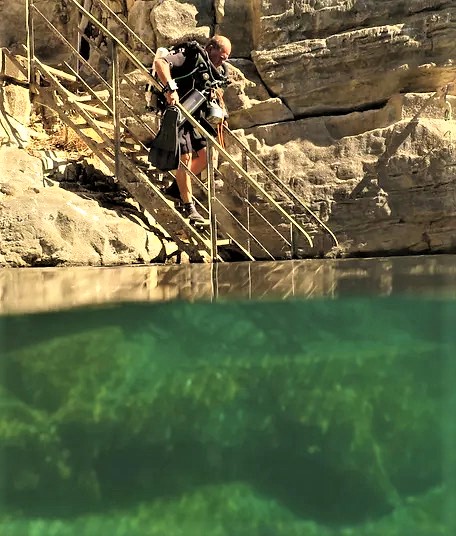 |
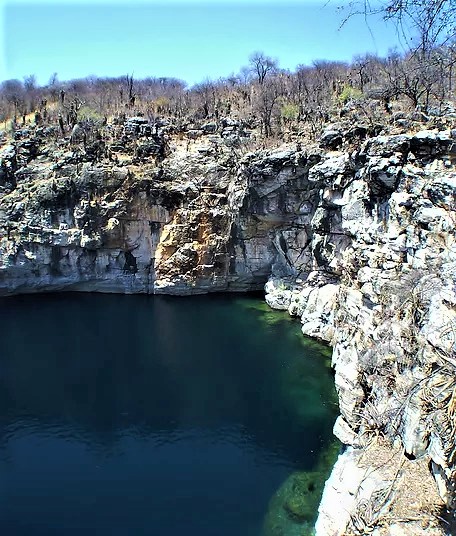 |
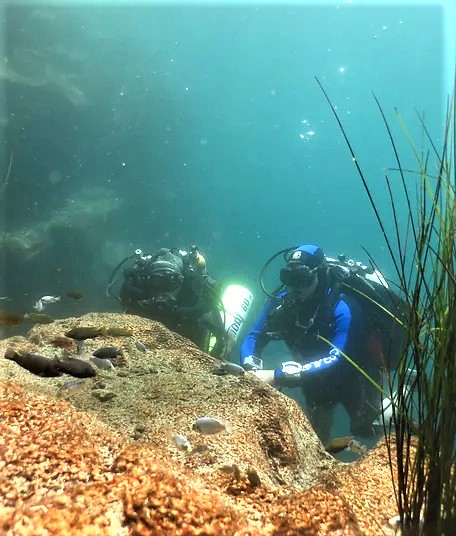 |
DIVING IN NAMIBIA
Diving in the caves and sinkholes in Namibia are all on an altitude of more than
1450 m above sea level and depths ranging from 30 to 130 meters. Our diving is therefore advanced technical diving, and special skills are required.
The caves in Namibia are classified as type III caves/sinkholes by the World Underwater Federation CMAS.
Training is therefore done with these conditions in mind; namely altitude and cave diving to CMAS standards. Any other qualifications are closely scrutinized and evaluated on an individual basis, always with at least a qualified CMAS/NUF instructor on hand during dives.
Please submit all diving qualifications and logbooks to the Federation for verification.
Guinas Lake:
 |
 |
 |
Water temperature in Namibia is moderate with lakes varying between 17 and 23 degrees
centigrade. Air temperatures vary between -2 degrees centigrade and 45 degrees centigrade (winter and summer).
Sea temperature is usually between 8 degrees and 18 degrees depending also on the season, etc.
The caves/sinkholes usually used for diving are not available to the general public diving.
Lake Otjikoto is a National Monument, and on private ground. To dive at the lake all groups must be assisted and accompanied by members of the Namibia Underwater Federation.
Otjikoto Lake:
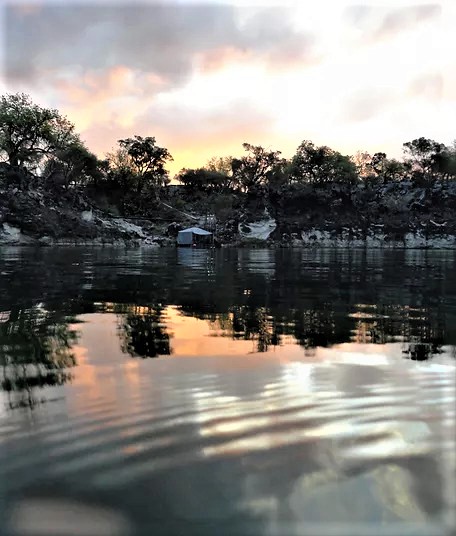 |
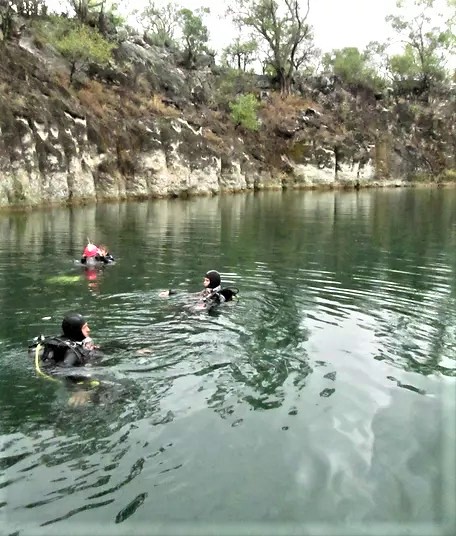 |
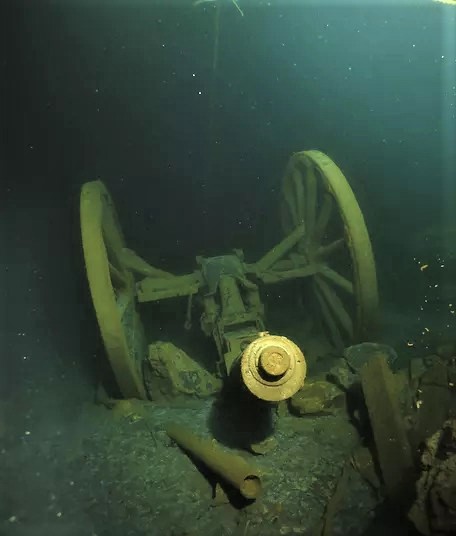 |
All other caves are on private land and not regularly visited, as the owners are generally not very positive about letting strangers onto their farms.
To dive in lakes like Harasib, Guinas and Dragons Breath, special qualifications and experience and abseiling techniques are required. To rig and de-rig these caves for diving, requires at least a week of work by a team of six people, where after a diver can only do two dives a day, whilst abseiling with full equipment. This in itself creates a logistical problem when time is of essence.
The notice at least three months in advance should be given by divers so that the appropriate arrangements can be made.
The best time to dive at lake Otjikoto will be during the time April to October. This is outside the rainy season and temperatures are moderate for camping. Lake Otjikoto is an easily accessible sinkhole for diving, and the favorite diving spot for divers in Namibia.
Background
Lake Otjikoto is a sinkhole; the name of this lake when loosely translated from Herero is "the place too deep for cattle to drink".
During the First World War, the German troops dumped a large number of ammunition and cannons with the ammunition wagons into this lake when they surrendered to the British troops. Today this is an underwater museum at a depth of between 48 and 52 meters.
Harasib Lake:
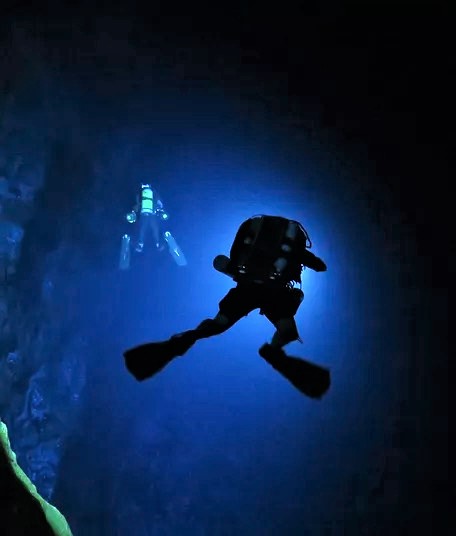 |
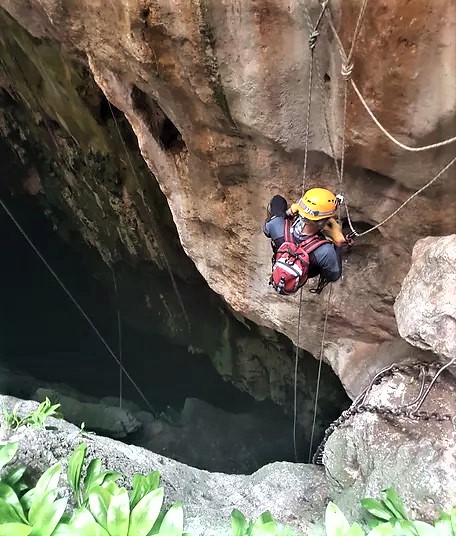 |
 |
Physical conditions:
Air temperature at the lake can vary between 40 degrees Celsius (day temperature summer) and minus 10 degrees Celsius at night in winter!
The area is still very untouched, therefore the diver needs to carry his full equipment down to the edge of the lake for about 100 meters on loose stones and gravel. To enter the lake, the diver has to climb down a steel ladder for 6 meters or jump down with full kit.
The depth of the sinkhole itself varies between 26 meters at the reef, where we do our workup dives, to 90 meters on the deepest point.
The legend of the lake being a bottomless pit, connected to other inland lakes and whirlpool swallowing the victims were proven wrong when divers of the Federation measured and mapped the entire lake with remote operated vehicles and sonar. It is basically a hole shaped like an inverted mushroom!
While diving at Lake Otjikoto, the Federation has a small part of the land available for camping.
The structure has been erected with very basic sanitary facilities (long drop and shower). Electricity is available at points to run equipment like fridges and recharge underwater lights etc.
All camping equipment is however the responsibilities of the individual divers.
Security is not a problem, as this is private area, fenced off from the public.
Conditions underwater:
Water temperature throughout the year varies between 18 and 25 degrees Celsius.
There are no currents etc, as this is an isolated lake.
Visibility varies between very poor (1 m) at certain times of the year, and 15 meters at best.
As is normal with cave diving is, buoyancy control is extremely important, as the entire bottom of the lake and walls of the overhangs are covered with a fine dust which can change visibility from perfect to zero within seconds.
As previously mentioned, the water level is at least 6 meters below the edge of the lake.
Qualifications required:
At least a two star CMAS qualification or equivalent with decompression diving experience.
In addition the divers should at least have some cave diving experience.
A fair level of fitness is required as it is necessary to carry full SCUBA equipment for a distance before and after a dive, and climb out of the water with this same equipment after a dive.
Minimum amount of dives recommended: are at least 75 to 100 dives with a minimum of 50 dives deeper than 40 meters.
No medical/psychological restrictions should be present for the diver. Medical
certificates and logbooks will be checked by the instructors/guides. The divers
will have to sign an indemnity form, to indemnify the Federation from any
liability in the case of an accident.
Dragon's Breath Lake:
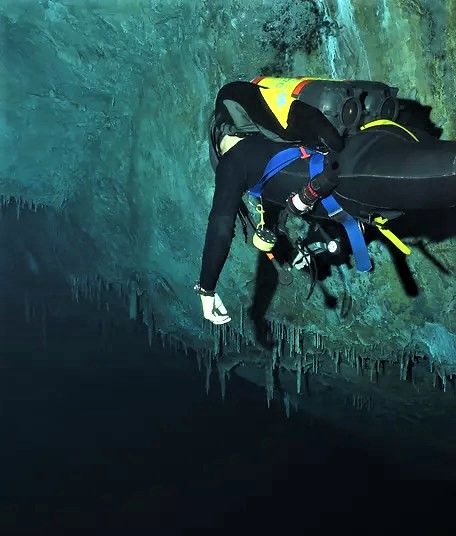 |
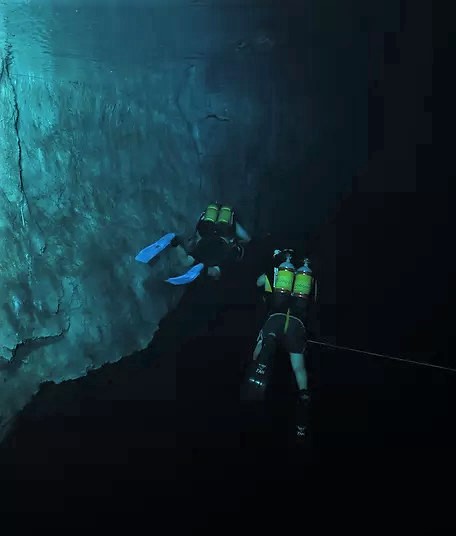 |
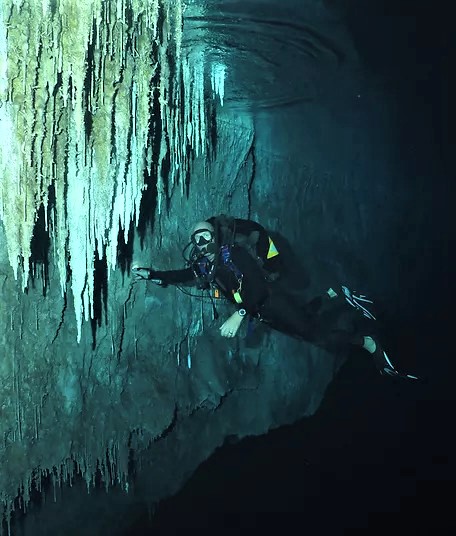 |
Other:
Divers require DAN insurance. This covers all medical and evacuation expenses in the event of accidents.
We do have access to a decompression facility as well as fully trained hyperbaric medicine paramedics with MRI Namibia. We are also ensured individually at DAN SA, it is required that these divers all do the same.
A group of divers needs at least 3 days for workup dives and deep dives (a safety rule that cannot be bent)
A typical diving program per day will be the following:
08H30 - 11H30 Diving commences in pairs of two divers and one instructor/guide. The next group acts as standby divers.
11H30 - 14H30 Filling of cylinders and lunch, each normally responsible for his own.
15H00 - 17H30 Second dive in the same pairs as before.
18H00 - onwards. Filling of cylinders and braai/social etc.
Physical requirements (medical and physiological):
It is recommended that divers should have an intake of at lest 4-5 liters of fluids during a day of diving, Alcoholic drinks only allowed after completion of the day's dives. The federation regards this as a very strict safety rule. (The general rule is 12 hours flask to mask).
This is also a very dense Malaria area, so be sure that the necessary precautions are taken beforehand.
The area is also infested with snakes, spiders etc, so the wearing of shoes and proper clothing is essential, especially at night.
The sun is extremely severe throughout the year, so an effective sun block is a MUST.
The following diving equipment is needed for diving at lake Otjikoto:
Demand Valve with Octopus
ABLJ/DV in good working order
Wetsuit if required by the diver suitable for water of between 18 and 23 degrees Celsius
Flippers
Mask
2 x secondary light sources (torches) compatible for a depth of up to 100 meters
Diving knife
Dive computer (we use Alladin Pro or Air-X) or any computer based on the Swiss decompression tables
Logbooks and certificates
Weight belt and weights for fresh water dives
Cylinders 10 to 12 liters, depending on the diver's air consumption
Equipment available for rental from the club includes:
Cylinders
Weights
ABLJ's
DV training rigs
It can also be arranged that the group visit the club house in Windhoek where
there is a marine archaeology museum and lovely facilities. A slideshow of marine activities in
Namibia can be organized on request.
Adventure in Namibia ACCOMMODATION RESERVATIONS SAFARI VW MICROBUS TO RENT
Contact & information:
E-mail:
info@namibweb.com
Page created and serviced by

www.namibweb.com
Copyright © 1998-2025
namibweb.com - The online guide
to Namibia
All rights reserved |
JOIN
|
VIDEO PORTFOLIO
|
VIDEO/PHOTO COLLECTION
Telegram
| YouTube |
Blog
Page is sponsored by ETS &
Exploring Namibia TV
Disclaimer: no matter how often this page is updated and its accuracy is checked,
www.namibweb.com and ETS
will not be held
responsible for any change in opinion, information, facilities, services,
conditions, etc. offered by
establishment/operator/service/information provider or any third party